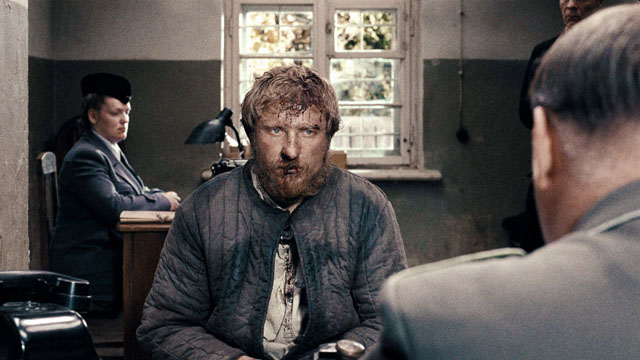“The Ukrainian director and former documentary-maker Sergei Loznitsa scored a succès d’éstime with his first fiction feature My Joy, which was in competition in Cannes two years ago,” begins the Guardian‘s Peter Bradshaw. “Now he has returned with a mysterious, compelling and grim story from the Nazi-Occupied Soviet Union in 1942, shrouded in the fog of war, the fog of fear and the fathomless fog of European history—comparable, perhaps, to Elem Klimov’s 1985 film Come and See.”
That would be at the top of a list to which Stephen Dalton, writing in the Hollywood Reporter, adds Mikhail Kalatozov‘s The Cranes are Flying and Andrei Tarkovksy‘s Ivan’s Childhood. “Possibly mindful of this, Loznitsa’s addition to an already overstuffed canon takes the opposite stylistic approach, being essentially an intimate meditation on the tortuous Faustian dilemmas facing ordinary citizens under brutally sadistic regimes.”
“In the Fog‘s plot could be summed up as follows,” Domenico La Porta helpfully offers in Cineuropa (where Laurence Boyce explains why the film is a real boost to the Latvian film industry). “A man tries to make a moral choice in very immoral circumstances. In 1942, when Belorussia is occupied by the Nazis, this rail worker is accused of collaborating with the enemy when he is set free by a German officer after he is captured. Two partisans go to his home to punish him, and the man has no way to prove his innocence apart from his moral principles and humanity, which dictate his conduct in the presence of his two designated executioners. The film sets an unstoppable tragedy in motion, eventually leading two walls, two dead ends, to close in on him. The film’s characters are cold, gazes are empty, and feelings are eroded by general apathetic fatalism.”
Back to Stephen Dalton: “The three main players—Vladimir Svirski, Vladislav Abashin and Sergei Kolesov—are persuasively understated throughout, their faces etched with decades of grim resignation to cruel fate. No soundtrack music is allowed to add even a crumb of comfort to this joyless, blighted, purgatorial land.”
For Screen‘s Fionnuala Halligan, Loznitsa’s second feature “is a beautifully rigorous piece which will delight cineastes, his collaboration with cinematographer Oleg Mutu (who has also shot another Cannes Competition favorite, Beyond the Hills) moving up a notch to the point where the film’s visuals are palpably in sync with its protagonists and some notably effective sound design.”
Geoff Andrew in Time Out London: “Not unlike Nicholas Ray’s likewise philosophical Bitter Victory, In the Fog is a war movie that foregrounds the emotions of individuals over the spectacle of battle, and uses metaphor and a calm mood of ethical enquiry rather than simplistic polemics arguing for or against military engagement. Loznitsa knows that war exists and won’t go away; rather than indulging in patriotic or pacifistic platitudes, he tries to show what it might do to our souls. And, in this writer’s opinion, he succeeds.”
Updates: My Joy “was notable for its formal daring and structural gamesmanship, but In the Fog skews much more traditionally festival-elegant, juxtaposing lengthy tracking shots as the men walk or ride through dense forest with locked-down simplicity when they’re at rest,” writes Mike D’Angelo at the AV Club. “Loznitsa adapted it from a novel by Vasil Bykov, and I sense that there’s an interior monologue gone missing here, as is so often the case. It’s replaced, for the most part, by a sense of sodden futility that I honestly found a bit wearying.”
Jonathan Romney for Sight & Sound: “The film’s consideration on justice, moral integrity and martyrdom unfolds in a way that’s all the more telling because it’s so simple—and I’ve just had a conversation with someone who regarded the film as mundane. Yet to me, the theme’s development felt lucid in a particularly deep way – it’s the lucidity and depth of Tolstoy’s short stories.”
Variety‘s Leslie Felperin finds that “despite its classicism, Loznitsa’s helming still feels post-millennial in its austerity, particularly given the total absence of music and the slow-breath rhythms of its editing. The helmer doesn’t necessarily break new ground here, but he replows the field with precision.”
Update, 5/31: Glenn Heath Jr. for the L: “Entirely constructed from brilliant long tracking shots that stalk worn-out characters slowly traversing a landscape dominated by silence and sudden violence, In the Fog explores the organic overlap between ideology and physical action within a volatile space. The background of each fluid frame momentarily hints at other experiences grappling with same dynamic, people caught in the middle of life-changing moments.”
Cannes 2012 Index: a guide to the coverage of the coverage. For news and tips throughout the day every day, follow @KeyframeDaily on Twitter and/or the RSS feed. Get Keyframe Daily in your inbox by signing in at fandor.com/daily.




